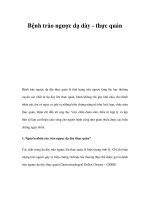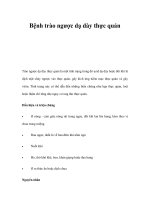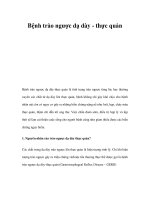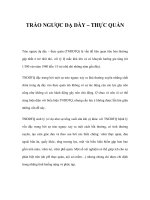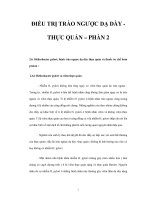trào ngược dà dày thực quản (GERD)
Bạn đang xem bản rút gọn của tài liệu. Xem và tải ngay bản đầy đủ của tài liệu tại đây (557.35 KB, 10 trang )
Gastroesophageal reflux disease
I/ Summary
Gastroesophageal reflux disease (GERD) is a chronic condition in which retrograde flow of stomach contents into the esophagus causes
irritation to the epitheliallining. Reflux episodes are primarily caused by inappropriate, transient relaxation of the lower esophageal
sphincter (LES). Risk factors include smoking, alcohol consumption, stress, obesity, and anatomical abnormalities of the esophagogastric
junction (e.g., hiatal hernia). The chief complaint is retrosternal burning pain(heartburn), but a variety of other symptoms, such
as dysphagia and a feeling of increased pressure, are also common. Suspected GERD should already receive empirical treatment, but
further diagnostic steps, such as an upper endoscopy and/or 24-hour pH test, may be indicated to confirm the diagnosis. Management
involves lifestyle modifications, medications, and possibly surgery. Proton pump inhibitors (PPIs) are the treatment of choice, although
other agents – such as histamine H2-receptor antagonists (H2RAs) – may also be helpful. In addition to relieving symptoms,
treating esophagitis is especially important, as chronic mucosal damage can lead to a premalignant condition known as Barrett's
esophagus, further progressing to adenocarcinoma of the esophagus.
II/ Definition
Gastroesophageal reflux: regurgitation of stomach contents into the esophagus (can also occur in healthy individuals, e.g., after
consuming greasy foods or wine)
Gastroesophageal reflux disease (GERD): A condition in which reflux causes troublesome symptoms (typically
including heartburn or regurgitation) and/or esophageal injury/complications. The most common endoscopic finding associated
with esophageal mucosal injury is reflux esophagitis. [1]
NERD (non-erosive reflux disease): characteristic symptoms of gastroesophageal reflux disease in the absence of
esophageal injury, such as reflux esophagitis, on endoscopy (50–70% of GERD patients) [2]
ERD (erosive reflux disease): gastroesophageal reflux with evidence of esophageal injury, such as reflux esophagitis, on
endoscopy (30–50% of GERD patients)
III/ Epidemiology
Prevalence: ∼ 15–30% in the US (increases with age)
Sex: ♀ = ♂ [3]
IV/ Etiology
Main mechanism: transient lower esophageal sphincter relaxations (tLESRs) [5]
The dysfunctional LES loosens independent of swallowing and has a decreased ability to constrict, which
allows stomach contents to uncontrollably flow back into the esophagus (otherwise known as sphincter insufficiency).
Causes ∼⅔ of reflux episodes
Risk factors/associations
Lifestyle habits such as smoking, caffeine and alcohol consumption
Stress
Obesity
Pregnancy
Diaphragm dysfunction
Angle of His enlargement (> 60°)
Iatrogenic (e.g., after gastrectomy)
Inadequate esophageal protective factors (i.e., saliva, peristalsis) [5]
Gastrointestinal malformations and tumors: gastric outlet obstruction, gastric cardiac carcinoma
Scleroderma
Sliding hiatal hernia: ≥ 90% of patients with severe GERD
V/ Clinical features
Chief complaint: retrosternal burning pain (heartburn) that worsens while lying down (e.g., at night) and after eating
Pressure sensation in the chest
Belching, regurgitation
Dysphagia
Chronic non-productive cough and nocturnal cough
Nausea and vomiting
Halitosis
Triggers:
Bending down, supine position
Habits: smoking and/or alcohol consumption
Psychological factors: especially stress
VI/ Diagnostics
Empirical therapy: If GERD is clinically suspected and there are no indications for endoscopy, empiric therapy – ranging
from lifestyle modifications to a short trial with PPIs – should be initiated. A GERD diagnosis is assumed in patients who
respond to this therapeutic regimen.
Upper endoscopy (esophagogastroduodenoscopy (EGD))
Used to classify reflux esophagitis and conduct biopsies
Indications for endoscopy
Signs of complicated disease (e.g., dysphagia, painful swallowing, weight loss, iron deficiency anemia,
and aspiration pneumonia)
Extended course of symptoms
Noncardiac chest pain
No response to PPI treatment
Esophageal pH monitoring
Measured over 24 hours via nasogastric tube with a pH probe
Sudden drops to a pH ≤ 4 are consistent with episodes of acid reflux into the esophagus
Indications
To confirm suspected NERD
Before endoscopic or surgical treatment options are initiated in patients with NERD
GERD is diagnosed when drops in esophageal pH correlate with symptoms of acid reflux and precipitating activities
noted in the patient's event diary.
Esophageal manometry
A pressure-sensitive nasogastric tube measures the muscle contractions in several sections of the esophagus while the
patient swallows
Indications:
Ensure correct placement of pH probes
Evaluate peristaltic function prior to anti-reflux surgery
Exclude motor disorders that may mimic the symptoms of GERD
VII/ Pathology
The histopathological findings vary depending on the severity of mucosal damage:
Superficial coagulative necrosis in the non-keratinized squamous epithelium
Thickening of the basal cell layer
Elongation of the papillae in the lamina propria and dilation of the vascular channels at the tip of the papillae (→ hyperemia)
Inflammatory cells (granulocytes, lymphocytes, macrophages)
Transformation of squamous into columnar epithelium → Barrett's metaplasia
VIII/ Differential diagnoses
1. Other forms of esophagitis
Infectious esophagitis: generally in immunocompromised patients
Esophageal candidiasis: Endoscopy shows white or yellowish adherent plaques.
Herpes esophagitis: Endoscopy shows superficial ulcers in the upper or mid esophagus in the absence of plaques.
CMV esophagitis: Endoscopy shows distal mucosal erosions and ulcers; viral inclusion bodies in cell nuclei on biopsy.
Drug-induced esophagitis: Some medications may cause esophageal mucosal irritation, leading to erosions and ulcers.
Causes:
Antibiotics (e.g., tetracycline, doxycycline, and clindamycin)
Anti-inflammatory drugs (e.g., Aspirin)
Bisphosphonates (e.g., Alendronate)
Others (e.g., potassium chloride, quinidine, and iron compounds)
Endoscopic findings: punched-out ulcers with mild inflammatory changes of the surrounding mucosa
Eosinophilic esophagitis
Associated with allergic disease (allergic asthma, allergic rhinitis) in 50% of cases
Endoscopic findings
Circumferential mucosal lesions (rings/corrugations)
Mucosal fragility
Histological finding: increased number of eosinophils
2. Conditions not involving esophagitis
Cardiac: See differential diagnosis of chest pain (especially angina pectoris).
Gastrointestinal
Diffuse esophageal spasm
Achalasia
Osteochondrosis
Da Costa's syndrome (or neurocirculatory asthenia)
IX/ Treatment
1. Lifestyle modifications
Dietary
Small portions; avoid eating (< 3 hours) before bedtime
Avoid foods with high fat content
Physical
Normalize body weight
Elevate the head of the bed for patients with nighttime symptoms
Avoid toxins: nicotine, alcohol, coffee [13][7] , and certain drugs (e.g., calcium channel blockers, diazepam)
2. Medical therapy
Treatment of choice: Standard-dose of PPI for at least 8 weeks (once daily therapy)
No response: further diagnostic evaluation
Partial response: increase the dose (to twice daily therapy) or switch to a different PPI
Good response: discontinue PPI after 8 weeks
Maintenance therapy: if symptoms recur after discontinuation of PPIs and in the case of complications (see “Complications”
below)
After 8 weeks of initial treatment, reduce PPI to lowest effective dose or switch to H2RAs (only in patients without
complications!)
3. Surgical therapy
Indications
Equally effective alternative to medical therapy in certain patients with chronic GERD
Complications (e.g., Barrett's esophagus, strictures, recurrent aspiration)
Fundoplication
Symptoms resolve in 85% of cases, but recurrence is possible
Technique: The gastric fundus is wrapped around the lower esophagus and secured with stitches to form a cuff, leading
to a narrowing of the distal esophagus and the gastroesophageal junction (GEJ)and prevents reflux.
Nissen fundoplication (= complete fundoplication)
Complications
Intraoperative damage to the stomach and/or surrounding organs, especially
the esophagus, spleen, lungs/pleura (→ pneumothorax)
Gas bloat syndrome: inability to belch, leading to bloating and an increase in flatulence
Dysphagia (especially to solids)
Telescope phenomenon ("slipped Nissen"): the esophagus slides out of the wrapped stomach portion
Gastric denervation: Vagal nerve injury leads to bloating and cardiac complaints, resembling Roemheld
syndrome
If hiatal hernia is present [19]
Hiatoplasty: margins of the widened hiatus are sutured together
Fundopexy or gastropexy: the protruding part of the stomach is tethered to the diaphragm → keeps it in place and
relieves the tension placed on the cuff
X/ Complications
Reflux esophagitis: most common complication of GERD
Iron deficiency anemia: mucosal erosions and ulcerations → chronic bleeding → anemia
Esophageal stricture: most common sequela of reflux esophagitis
Clinical features: cause solid food dysphagia
Diagnostics
Barium esophagram (best initial test): narrowing of the esophagus at the gastroesophageal junction
Endoscopy with biopsies: to rule out malignancy and eosinophilic esophagitis
Treatment
First-line treatment: dilation with bougie dilator/balloon dilator + proton pump inhibitors in patients with reflux
In refractory cases (multiple recurrences): steroid injection prior to dilation, endoscopic electrosurgical incision
Recurrence occurs in the majority of patients; often multiple treatment attempts necessary
Esophageal ring:
Schatzki rings at the squamocolumnar junction are the most common type
Clinical features and management similar to that of an esopahgeal stricture
Aspiration of gastric contents leads to:
Aspiration pneumonia
Chronic bronchitis
Asthma (exacerbation)
Laryngitis and hoarseness
Barrett esophagus
Pathophysiology
Reflux esophagitis → stomach acid damages squamous epithelium → squamous epithelium becomes replaced
by columnar epithelium and goblet cells(intestinal metaplasia, Barrett's metaplasia) [3]
The physiological transformation zone ("Z-line") between squamous and columnar epithelium is shifted upwards
Pathology
Short-segment Barrett's esophagus (< 3 cm of columnar epithelium between Z-line and GEJ)
Long-segment Barrett's esophagus (> 3 cm of columnar epithelium between Z-line and GEJ) → higher cancer risk!
Complications: precancerous condition for adenocarcinoma (see esophageal cancer)
Management and surveillance
Medical treatment with PPIs
Endoscopy with four-quadrant biopsies at every 2 cm of the suspicious area (salmon colored mucosa)
If no dysplasia: repeat endoscopy every 3–5 years
If indefinite for dysplasia: repeat endoscopy with biopsies after 3–6 months of optimized PPI therapy
If low-grade dysplasia
Endoscopic therapy of mucosal irregularities
Alternatively: surveillance every 12 months with biopsies every 1 cm
If high-grade dysplasia: endoscopic therapy of mucosal irregularities
QUESTION
Q1. A 45-year-old woman comes to the physician because of progressive difficulty swallowing solids and liquids over the past 4 months.
She has lost 4 kg (9 lb) during this period. There is no history of serious illness. She emigrated to the US from Panama 7 years ago. She
does not smoke cigarettes or drink alcohol. Cardiopulmonary examination shows a systolic murmur and an S3 gallop. A barium
radiograph of the chest is shown. Endoscopic biopsy of the distal esophagus is most likely to show which of the following?
A. Atrophy of esophageal smooth muscle cells
B. Presence of intranuclear basophilic inclusions
C. Infiltration of eosinophils in the epithelium
D. Absence of myenteric plexus neurons
E. Presence of metaplastic columnar epithelium
Q2. A 58-year-old woman comes to the physician because of intermittent painful retrosternal dullness for 4 weeks. The pain is recurrent
and occurs when she exerts herself or when she is outside during cold weather. She also experiences shortness of breath and palpitations
during these episodes. The symptoms resolve spontaneously when she stops or sits down for a while. Over the past few days, the episodes
have increased in frequency. She has hypertension, type 2 diabetes mellitus, and osteoarthritis. Her left leg was amputated below the knee
after a motorcycle accident 25 years ago. She is currently waiting for a new prosthesis and walks on crutches. Current medications
include captopril, glyburide, and ibuprofen. She does not smoke or drink alcohol. Her pulse is 88/min, respirations are 20/min, and blood
pressure is 144/90 mm Hg. Cardiac examination shows no abnormalities. An x-ray of the chest shows no abnormalities. An ECG shows a
normal sinus rhythm. Serum cardiac markers are within the reference range. Which of the following is the most appropriate next step in
diagnosis?
A. Myocardial perfusion scan under pharmacological stress
B. Upper endoscopy
C. Coronary angiography
D. Echocardiography at rest
E. Repeat ECG under treadmill stress
F. Magnetic resonance angiography
Q3. A 52-year-old woman comes to the physician because of a 4-day history of painful swallowing and retrosternal pain. She was
diagnosed with HIV infection 2 months ago; her medications include tenofovir, emtricitabine, and raltegravir. Vital signs are within
normal limits. Physical examination of the oral cavity shows no abnormalities. The patient's CD4+ T-lymphocyte count is 70/mm3 (N ≥
500). Empiric treatment is started. Two weeks later, she reports no improvement in symptoms. Esophagogastroduodenoscopy is
performed and shows multiple round superficial ulcers in the distal esophagus. Which of the following is the most likely underlying cause
of this patient's symptoms?
A. Gastroesophageal junction incompetence
B. Adverse effect of medication
C. Infection with cytomegalovirus
D. Degeneration of ganglion cells within the myenteric plexuses
E. Diffuse esophageal spasm
F. Eosinophilic esophageal infiltrate
G. Infection with herpes simplex virus
H. Infection with Candida species
Q4. A 45-year-old woman comes to the physician because of a 5-month history of recurrent retrosternal chest pain that often wakes her
up at night. Physical examination shows no abnormalities. Upper endoscopy shows hyperemia in the distal third of the esophagus. A
biopsy specimen from this area shows non-keratinized stratified squamous epithelium with hyperplasia of the basal cell layer and
neutrophilic inflammatory infiltrates. Which of the following is the most likely underlying cause of this patient's findings?
A. Increased lower esophageal sphincter tone
B. Increased collagen production and fibrosis
C. Chronic gastrointestinal iron loss
D. Proximal migration of the gastroesophageal junction
E. Spread of neoplastic cells
F. Metaplastic transformation of the esophageal epithelium
Q5. A 38-year-old man comes to the physician because of an 8-month history of upper abdominal pain. During this period, he has also
had nausea, heartburn, and multiple episodes of diarrhea with no blood or mucus. He has smoked one pack of cigarettes daily for the past
18 years. He does not use alcohol or illicit drugs. Current medications include an antacid. The abdomen is soft and there is tenderness to
palpation in the epigastric and umbilical areas. Upper endoscopy shows several ulcers in the duodenum and the upper jejunum as well as
thick gastric folds. Gastric pH is < 2. Biopsies from the ulcers show no organisms. Which of the following tests is most likely to confirm
the diagnosis?
A. 24-hour esophageal pH monitoring
B. Fasting serum gastrin level
C. Urine metanephrine levels
D. Urea breath test
E. Serum vasoactive intestinal polypeptide level
Q6. A 1-month-old male infant is brought to the physician because of inconsolable crying for the past 3 hours. For the past 3 weeks, he
has had multiple episodes of high-pitched unprovoked crying every day that last up to 4 hours and resolve spontaneously. He was born at
term and weighed 2966 g (6 lb 9 oz); he now weighs 3800 g (8 lb 6 oz). He is exclusively breast fed. His temperature is 36.9°C (98.4°F)
and pulse is 140/min. Examination shows a soft and nontender abdomen. The remainder of the examination shows no abnormalities.
Which of the following is the most appropriate next step in management?
A. Perform lumbar puncture
B. Administer simethicone
C. Administer pantoprazole
D. Reassurance
E. Recommend the use of Gripe water
Q7. A 58-year-old man comes to the physician for recurrent heartburn for 12 years. He has also developed a cough for a year, which is
worse at night. He has smoked a pack of cigarettes daily for 30 years. His only medication is an over-the-counter antacid. He has not seen
a physician for 8 years. He is 175 cm (5 ft 9 in) tall and weighs 95 kg (209 lb); BMI is 31 kg/m2. Vital signs are within normal limits.
There is no lymphadenopathy. The abdomen is soft and nontender. The remainder of the examination shows no abnormalities. A
complete blood count is within the reference range. An upper endoscopy shows columnar epithelium 2 cm from the gastroesophageal
junction. Biopsies from the columnar epithelium show low-grade dysplasia and intestinal metaplasia. Which of the following is the most
appropriate next step in management?
A. Repeat endoscopy in 18 months
B. Endoscopic therapy
C. Esophagectomy
D. Omeprazole, clarithromycin, and metronidazole therapy
E. External beam radiotherapy
F. Nissen fundoplication
Q8. A 34-year-old man comes to the physician for a follow-up examination. He has a 3-month history of a nonproductive cough. He has
been treated with diphenhydramine since his last visit 2 weeks ago, but his symptoms have persisted. He does not smoke. He drinks 3
beers on the weekends. He is 177 cm (5 ft 10 in) tall and weighs 100 kg (220.46 lbs); BMI is 35.1 kg/m2. His temperature is 37.1°C
(98.8°F), pulse is 78/min, respirations are 14/min, and blood pressure is 130/80 mm Hg. Pulse oximetry on room air shows an oxygen
saturation of 97%. Physical examination and an x-ray of the chest show no abnormalities. Which of the following is the most appropriate
next step in management?
A. Azithromycin therapy
B. Pulmonary function testing
C. Omeprazole therapy
D. Tuberculin skin test
E. Oral corticosteroid therapy
F. CT scan of the chest
Q9. A 45-year-old man comes to the physician for the evaluation of painful swallowing and retrosternal pain over the past 2 days. He was
recently diagnosed with HIV infection, for which he now takes tenofovir, emtricitabine, and raltegravir. There is no family history of
serious illness. He has smoked one pack of cigarettes daily for the past 20 years. He drinks 2–3 beers per day. He does not use illicit
drugs. Vital signs are within normal limits. Physical examination of the oral cavity shows no abnormalities. The patient's CD4+ Tlymphocyte count is 80/mm3 (normal ≥ 500). Empiric treatment is started. Two weeks later, he reports no improvement in his symptoms.
Esophagogastroduodenoscopy is performed and shows multiple well-circumscribed, round, superficial ulcers in the upper esophagus.
Which of the following is the most likely underlying cause of this patient's symptoms?
A. Infection with herpes simplex virus
B. Adverse effect of medication
C. Transient lower esophageal sphincter relaxation
D. Allergic inflammation of the esophagus
E. Degeneration of inhibitory neurons within the myenteric plexuses
F. Diffuse esophageal spasm
G. Infection with Candida species
H. Infection with cytomegalovirus
Q10. A 68-year-old man comes to the physician because of recurrent episodes of nausea and abdominal discomfort for the past 4 months.
The discomfort is located in the upper abdomen and sometimes occurs after eating, especially after a big meal. He has tried to go for a
walk after dinner to help with digestion, but his complaints have only increased. For the past 3 weeks he has also had symptoms while
climbing the stairs to his apartment. He has type 2 diabetes mellitus, hypertension, and stage 2 peripheral arterial disease. He has smoked
one pack of cigarettes daily for the past 45 years. He drinks one to two beers daily and occasionally more on weekends. His current
medications include metformin, enalapril, and aspirin. He is 168 cm (5 ft 6 in) tall and weighs 126 kg (278 lb); BMI is 45 kg/m2. His
temperature is 36.4°C (97.5°F), pulse is 78/min, and blood pressure is 148/86 mm Hg. On physical examination, the abdomen is soft and
nontender with no organomegaly. Foot pulses are absent bilaterally. An ECG shows no abnormalities. Which of the following is the most
appropriate next step in diagnosis?
A. Esophagogastroduodenoscopy
B. CT scan of the abdomen
C. CT angiography of the abdomen
D. Hydrogen breath test
E. Cardiac stress test
F. Abdominal ultrasonography of the right upper quadrant
G. Endoscopic retrograde cholangiopancreatography
Q11. A 28-year-old man comes to the physician because of a 1-year history of chronic back pain. He explains that the pain started after
getting a job at a logistics company. He does not recall any trauma and does not have morning stiffness or neurological symptoms. He has
been seen by two other physicians for his back pain who did not establish a diagnosis. The patient also has abdominal bloating and a
feeling of constipation that started 3 weeks ago. After doing extensive research on the internet, he is concerned that the symptoms might
be caused by pancreatic cancer. He would like to undergo a CT scan of his abdomen for reassurance. He has a history of episodic chest
pain, for which he underwent medical evaluation with another healthcare provider. Tests showed no pathological results. He does not
smoke or drink alcohol. He reports that he is under significant pressure from his superiors due to frequent performance evaluations. He
takes daily multivitamins and glucosamine to prevent arthritis. His vital signs are within normal limits. Examination shows a soft, nontender, non-distended abdomen and mild bilateral paraspinal muscle tenderness. The remainder of the examination, including a
neurologic examination, shows no abnormalities. Laboratory studies are within the reference range. An x-ray of the spine shows no
abnormalities. Which of the following is the most likely explanation for this patient's symptoms?
A. Adjustment disorder
B. Malignant neoplasm
C. Illness anxiety disorder
D. Atypical depression
E. Irritable bowel syndrome
F. Conversion disorder
G. Somatic symptom disorder
H. Acute stress disorder
Q12. A 58-year-old man comes to the physician for the evaluation of intermittent dysphagia for 6 months. He states that he drinks a lot of
water during meals to help reduce discomfort he has while swallowing food. He has hypertension and gastroesophageal reflux disease.
He has smoked one half-pack of cigarettes daily for 32 years. He does not drink alcohol. Current medications include hydrochlorothiazide
and ranitidine. He is 173 cm (5 ft 8 in) tall and weighs 101 kg (222 lb); BMI is 33.7 kg/m2. His temperature is 37°C (98.6°F), pulse is
75/min, and blood pressure is 125/75 mm Hg. The lungs are clear to auscultation. Cardiac examination shows no murmurs, rubs, or
gallops. The abdomen is soft and nontender. A barium esophagogram shows complete obstruction at the lower end of the esophagus with
an irregular filling defect. An upper endoscopy shows a sliding hiatal hernia and a constricting ring at the gastroesophageal junction.
Biopsies from the lesion show squamocolumnar epithelium with no metaplasia. Which of the following is the most appropriate next step
in the management of this patient?
A. Esophagectomy
B. Esophageal stent
C. Intralesional corticosteroid
D. Iron supplementation
E. Omeprazole therapy
F. Nissen fundoplication
G. Mechanical dilation
Q13. A 68-year-old man comes to the physician because of a 4-month history of bad breath and progressive difficulty swallowing solid
food. Physical examination shows no abnormalities. An upper endoscopy is performed and a photomicrograph of a biopsy specimen
obtained from the mid-esophagus is shown. Which of the following best explains the findings in this patient?
A. Well-differentiated neoplastic glandular proliferation
B. Atrophy and fibrosis of the esophageal smooth muscle
C. Metaplastic transformation of esophageal mucosa
D. Neoplastic proliferation of squamous epithelium
E. Eosinophilic infiltration of the esophageal walls
Q14. A previously healthy 37-year-old man comes to the physician for the evaluation of a 8-week history of intermittent burning
epigastric pain. During this period, he has also felt bloated and uncomfortable after meals. He has not had weight loss or a change in
bowel habits. He has no personal or family history of serious illness. He takes no medications. He does not smoke. He drinks 1–3 beers
per week. Vital signs are within normal limits. Abdominal examination shows mild epigastric tenderness on palpation without guarding
or rebound tenderness. Bowel sounds are normal. The remainder of the examination shows no abnormalities. Which of the following is
the most appropriate next step in management?
A. Urea breath test
B. Helicobacter pylori eradication therapy
C. Helicobacter pylori serum IgG
D. Proton pump inhibitors
E. Upper gastrointestinal endoscopy
F. Abdominal ultrasonography
Q15. A 60-year-old woman comes to the physician because of a 2-week history of severe, retrosternal chest pain. She also has pain when
swallowing solid food and medications. She has hypertension, type 2 diabetes mellitus, poorly-controlled asthma, and osteoporosis. She
was recently admitted to the hospital for an acute asthma exacerbation that was treated with bronchodilators and a 7-day course of oral
corticosteroids. Her current medications include aspirin, amlodipine, metformin, insulin, beclomethasone and albuterol inhalers, and
alendronate. Vital signs are within normal limits. Examination of the oral pharynx appears normal. The lungs are clear to auscultation. An
upper endoscopy shows a single punched-out ulcer with normal surrounding mucosa at the gastroesophageal junction. Biopsies of the
ulcer are taken. Which of the following is the most appropriate next step in management?
A. Start ganciclovir
B. Discontinue alendronate
C. Start nystatin
D. Start pantoprazole
E. Discontinue amlodipine
F. Start fluconazole
Q16. A 37-year-old man comes to the physician because of a 1-month history of a burning sensation in his chest. The sensation is most
prominent when he is lying in bed, but it is also present after eating heavy meals. He also states his breath has an unpleasant odor in the
morning. He has not lost any weight during this period. He has hypothyroidism. His father died of colon cancer and his mother has
hypertension. He has smoked one pack of cigarettes daily for 15 years and drinks 2–3 beers on weekends. His medications include
levothyroxine and an over-the-counter multivitamin. He is 170 cm (5 ft 7 in) tall and weighs 95 kg (210 lb); BMI is 32.9 kg/m2. Vital
signs are within normal limits. Physical examination shows no abnormalities. Which of the following is the next best step in
management?
A. Esophagogastroduodenoscopy
B. Urea breath test
C. Proton-pump inhibitor
D. H2 receptor blocker
E. Barium swallow
F. Amoxicillin and clarithromycin
G. Calcium carbonate
Q17. A previously healthy 55-year-old man comes to the physician because of a 5-month history of progressively worsening substernal
chest pain after meals. The pain occurs almost daily, is worst after eating spicy food or drinking coffee, and often wakes him up from
sleep at night. He has not had any weight loss. He has smoked 1 pack of cigarettes daily for 35 years and he drinks 1 to 2 glasses of wine
daily with dinner. Physical examination is unremarkable. Esophagogastroduodenoscopy shows erythema of the distal esophagus with two
small mucosal erosions. Biopsy specimens obtained from the esophagus show no evidence of metaplasia. Without treatment, this patient
is at greatest risk for which of the following complications?
A. Esophageal adenocarcinoma
B. Esophageal squamous cell carcinoma
C. Laryngeal carcinoma
D. Esophageal stricture
E. Sliding hiatal hernia
F. Pyloric stenosis
Q18. A 36-year-old woman comes to the physician because of a 12-month history of upper abdominal pain. The pain is worst after
eating, when it is 7 out of 10 in intensity. During this period she has also had nausea, heartburn, and multiple episodes of diarrhea with no
blood or mucus. Eight months ago, she underwent an upper endoscopy, which showed several ulcers in the gastric antrum, the pylorus,
and the duodenum, as well as thick gastric folds. The biopsies from these ulcers were negative for H. pylori. Current medications include
pantoprazole and over-the-counter antacids. She appears anxious. Vital signs are within normal limits. Cardiopulmonary examination
shows no abnormalities. The abdomen is soft and there is tenderness to palpation in the epigastric and umbilical areas. Test of the stool
for occult blood is positive. A repeat upper endoscopy shows persistent gastric and duodenal ulceration with minimal bleeding. Which of
the following is the most appropriate next step in diagnosis?
A. Secretin stimulation test
B. Urea breath test
C. 24-hour esophageal pH monitoring
D. Fasting serum gastrin level
E. CT scan of the abdomen and pelvis
Q19. Three days after undergoing open surgery to repair a bilateral inguinal hernia, a 66-year-old man has new, intermittent upper
abdominal discomfort that worsens when he walks around. He also has new shortness of breath that resolves with rest. There were no
complications during surgery or during the immediate postsurgical period. Ambulation was restarted on the first postoperative day. He
has type 2 diabetes mellitus, hypercholesterolemia, asthma, and hypertension. He has smoked one pack of cigarettes daily for 25 years.
Prior to admission, his medications included metformin, simvastatin, an albuterol inhaler, and lisinopril. His temperature is 37°C
(98.6°F), pulse is 80/min, respirations are 16/min, and blood pressure is 130/80 mm Hg. Pulse oximetry on room air shows an oxygen
saturation of 98%. The abdomen is soft and shows two healing surgical scars with moderate serous discharge. Cardiopulmonary
examination show no abnormalities. ECG at rest shows no abnormalities. Cardiac enzyme levels are within the reference range. An x-ray
of the chest and abdominal ultrasonography show no abnormalities. Which of the following is the most appropriate next step in
diagnosis?
A. Serum D-dimer level
B. Magnetic resonance imaging of the abdomen
C. Spirometry
D. Cardiac exercise stress test
E. Culture swab from the surgical site
F. Coronary angiography
G. Magnetic resonance angiography of the thorax
H. Cardiac pharmacological stress test
I. Esophagogastroduodenoscopy
Q20. A 56-year-old man comes to the physician because of intermittent retrosternal chest pain. Physical examination shows no
abnormalities. Endoscopy shows salmon pink mucosa extending 5 cm proximal to the gastroesophageal junction. Biopsy specimens from
the distal esophagus show nonciliated columnar epithelium with numerous goblet cells. Which of the following is the most likely cause of
this patient's condition?
A. Neoplastic proliferation of esophageal epithelium
B. Esophageal exposure to gastric acid
C. Atopic inflammation of the esophagus
D. Hypermotile esophageal contractions
E. Fungal infection of the lower esophagus
F. Incomplete relaxation of lower esophageal sphincter
ANSWER:
1A
2D
16C
17D
3G
18D
4D
19H
5B
20B
6D
7B
8B
9A
10E
11G
12G
13D
14A
15B



